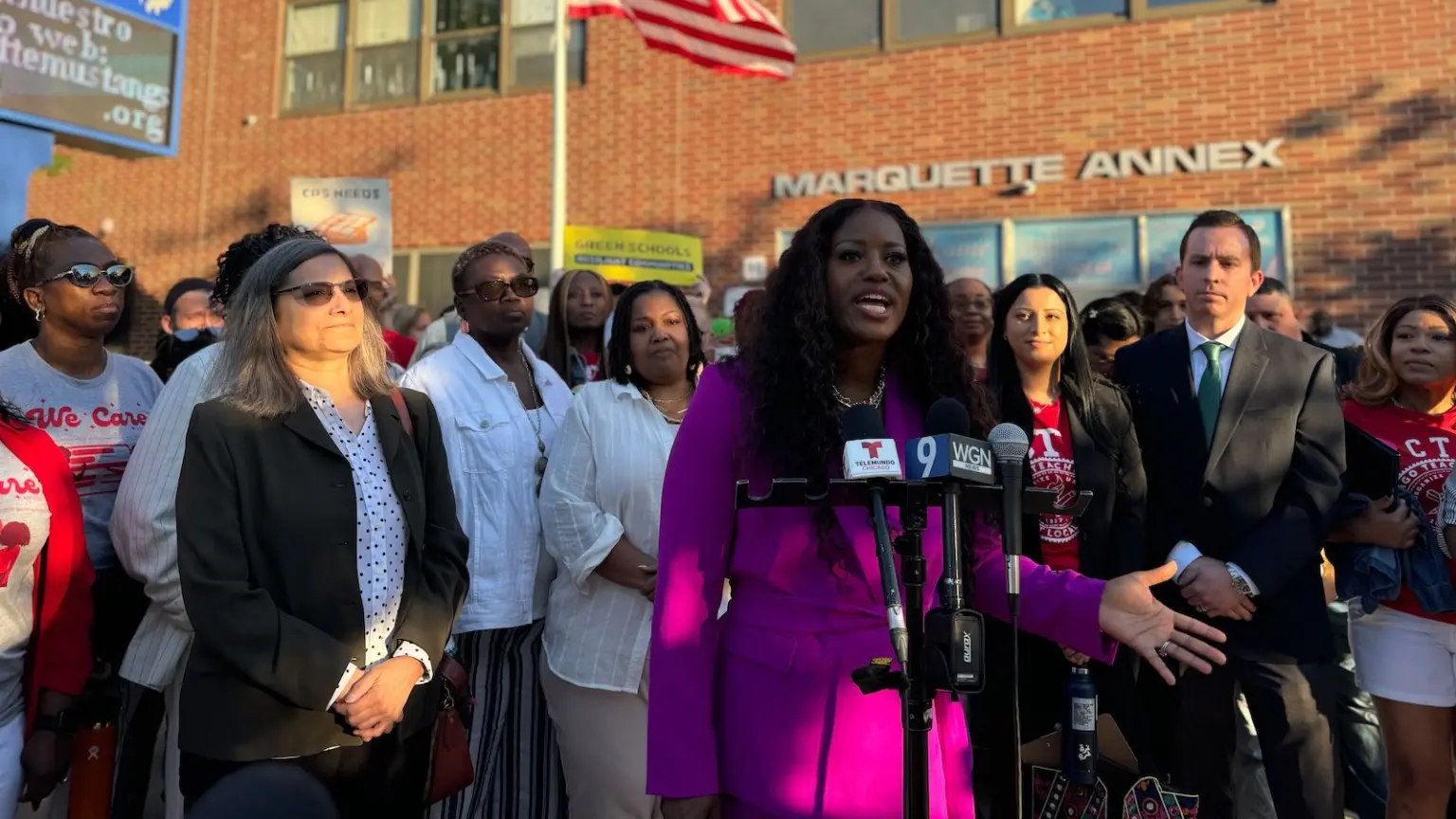
By Juanpablo Ramirez-Franco, Grist
This story was originally published by Grist. Sign up for Grist’s weekly newsletter here.
This coverage is made possible through a partnership between WBEZ and Grist, a nonprofit environmental media organization. Sign up for WBEZ newsletters to get local news you can trust.
Solar panels. Heat Pumps. Electric buses. Those are just three of the things the Chicago Teachers Union, or CTU, is hoping to acquire in their latest negotiations for a new contract, one that would address the rising toll of climate change in the more than 500 schools in which their members teach.
Arguably one of the most powerful unions for teachers in the nation, the CTU held public negotiations last Friday in a crowded elementary school gymnasium, facing off against leaders from Chicago Public Schools, or CPS.
The two entities have a contentious relationship, made clear in the last decade with two strikes and several showdowns during the pandemic. The negotiations were also streamed, but any observers expecting the usual verbal fireworks would be disappointed. Both sides agreed that climate change is a real challenge. Now, they just have to figure out how to pay for the changes necessary.
“Chicago’s buildings, including school buildings, are a major source of carbon emissions,” said Lauren Bianchi, a social studies teacher on the city’s Southeast Side and chair of the CTU’s climate justice committee. “CPS buildings produce yearly emissions equivalent to about 900 railcars’ worth of coal.”
Nationwide, the Biden administration has encouraged school districts to begin thinking about cutting their climate emissions. To that end, the federal government has funneled millions of dollars in federal grants and technical assistance to help schools install solar panels, purchase electric buses, and update heating and cooling systems. But from California to Massachusetts, teachers unions have already started to get loud about climate justice demands.
As heat and extreme weather become more prevalent because of the climate crisis, J. Mijin Cha, an environmental studies professor at the University of California, Santa Cruz, said it makes sense that climate demands are turning up in union negotiations.
“If you want a green school, you have to really think about what the challenges of the climate crisis will bring to students who are trying to study,” said Cha. “Things like heat and other things that will intensify from the climate crisis are then educational issues.”
In April, Stacey Davis Gates, the union’s president, announced a “transformative” contract proposal in which increased wages were just a starting point. The plan included hundreds of items ranging from a plan to build more affordable housing citywide to providing additional resources for the thousands of migrant children shuttled to Chicago from the Mexican border. On top of that, the union wants energy efficiency and climate resiliency written into their new contract.
To start, the CTU wants to bring the school district’s aging infrastructure into the 21st century. Chicago’s school campuses are on average more than 80 years old, twice the national average according to the National Center for Educational Statistics. The oldest school still in operation dates back to 1871, the same year as the Great Chicago Fire.
And keeping the lights on in the city’s old public schools isn’t cheap.

The Chicago Teachers Union and Chicago Public Schools opened up contract negotiation to the public for the first time. Juanpablo Ramirez-Franco/Grist
“Chicago Public Schools will face more than a billion dollars in climate driven cooling costs by 2025,” Ayesha Qazi-Lampert, an environmental science teacher, explained.
The CTU wants to transform the city’s schools into “climate-resilient community hubs,” Qazi-Lampert said to the crowd. To do it, the union wants the school district to install heat pumps, transition to solar and geothermal power, and get all lead contamination out of the school’s drinking water.
Outside the school campuses, the teachers union wants more green spaces — expanded urban canopies and native gardens that beautify the neighborhood and capture stormwater.
“Our school buildings were not designed to withstand frequent and immediate hot and cold extremes,” said Qazi-Lampert. “We’re not only testing the integrity of the building materials, but we’re adding stress to already outdated cooling and heating systems.”
It isn’t just physical infrastructure the union wants to modernize, but also what happens inside classrooms and cafeterias. The CTU is calling for expanded career technical education that puts Chicago students on track for jobs in the emerging clean energy economy. And better lunches for the students to keep students full while they learn inside their newly solar-powered school.
But these updates won’t be quick and they won’t be cheap. Money, especially in the upcoming year, is in short supply. CPS is staring down a nearly $400 million deficit for the next school year as pandemic relief funding is beginning to run dry.
On top of impending budgetary shortfalls, CPS’s chief facilities officer, Ivan Hansen, said there is already a massive backlog of deferred updates. “Our total district immediate critical need is over $3 billion and that is just to bring the buildings to a good repair,” he said.
Still, CPS leadership agrees with the union on the broadest points: CPS has a massive footprint across the city, with over 62 millions square feet in building space and most of it is in decline. On the finer details, the city still had questions.
In one instance, David Singler, the energy and sustainability program manager for CPS, rebuffed the union’s plans to install solar panels en masse. “If we were to take every square inch of roof and put a solar panel on it, it would only generate a fraction of the amount of energy that we need in the district to operate our buildings,” he said.
Before wrapping up its first public bargaining sessions, CPS and CTU agreed to collaborate more closely on grant applications in the future. Most everything else was left in the air.
But the union is set on getting the district to enshrine its climate-mitigation proposals into the upcoming contract. Davis Gates explains that responding to climate change must be a priority, not just for the union but for the district.
“That contract means nothing if our Earth is on fire,” she said.
Correction: This story originally misstated the year of the Great Chicago Fire.
This article originally appeared in Grist at https://grist.org/accountability/chicago-teachers-want-climate-solutions-next-contract/.
Grist is a nonprofit, independent media organization dedicated to telling stories of climate solutions and a just future. Learn more at Grist.org.
Catch more news at Great Lakes Now:
In Chicago, one neighborhood is fighting gentrification and climate change at the same time
Chicago could be first major Midwestern city to ban gas in new construction
Featured image: Juanpablo Ramirez-Franco/Grist




